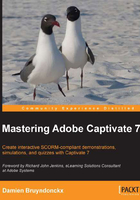
Chapter 2. Capturing the Slides
Now that you have a better understanding of the features offered by Captivate, it is time to discover the first step of the production process: capturing the slides.
This step can be compared to the filming of a movie. When filming a movie, the director wants to capture all the images, sequences, and shots he needs. In the movie industry, this raw material is called the rushes. When the filming is complete, the director goes back to the studio to start the post-production process. It is during the post-production step of the process that the final movie takes shape. Only the best rushes will make their way to the movie theatre while the others will be discarded along the way. That being said, the post-production phase can only be successful if the filming provides enough good-quality material to create a great movie.
The same basic idea applies to Captivate. When capturing the slide, one should always keep in mind the fact that the post-production phase will follow. Therefore, the goal of the capture phase is to create enough quality slides to ensure the success of the next phase of the process.
At the end of this chapter, you will be far from the final result you want to achieve, but you will have enough slides to start editing your projects.
In this chapter, we will be:
- Discussing how to choose the right size/resolution for the project
- Discussing the recording preferences and the recording modes
- Recording Demonstrations and Simulations
- Recording System Audio
- Discussing and using Full Motion Recording
- Discussing and experiencing the Video Demo recording mode
- Using manual panning
- Resizing a project
If you are ready, it's almost time to turn the camera on and start the real action!